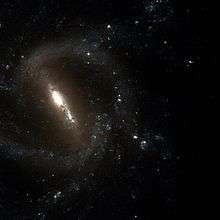NGC 1073
| NGC 1073 | |
|---|---|
|
An image of NGC 1073. | |
| Observation data (J2000 epoch) | |
| Constellation | Cetus |
| Right ascension | 02h 43m 40.5s[1] |
| Declination | +01° 22′ 34″[1] |
| Redshift | 1208 ± 5 km/s[1] |
| Apparent magnitude (V) | 11.5[1] |
| Characteristics | |
| Type | SB(rs)c[1] |
| Apparent size (V) | 4′.9 × 4′.5[1] |
| Other designations | |
| UGC 2210,[1] PGC 10329[1] | |
NGC 1073 is a barred spiral galaxy in the constellation Cetus. It probably has an H II nucleus.[2][3] NGC 1073 is about 55 million light years from Earth. NGC 1073 is about 80,000 light years across. NGC 1073 can be viewed with a mid-sized telescope and is found in the Cetus constellation, also called the Sea Monster. NGC 1073 is barred spiral galaxy like the Milky Way, unlike the Milky Way NGC 1073 does not have well formed symmetrical arms and the center bar is larger.[4]

NGC 1073 by HST, 3.18′ view
References
- 1 2 3 4 5 6 7 8 NED (February 25, 2007), Results for search on NGC 1073
- ↑ Ho, Luis C.; Filippenko, Alexei V.; Sargent, Wallace L. W. (October 1997), "A Search for "Dwarf" Seyfert Nuclei. III. Spectroscopic Parameters and Properties of the Host Galaxies", Astrophysical Journal Supplement, 112 (2), pp. 315–390, arXiv:astro-ph/9704107
 , Bibcode:1997ApJS..112..315H, doi:10.1086/313041
, Bibcode:1997ApJS..112..315H, doi:10.1086/313041 - ↑ Staff (3 February 2012). "Hubble Telescope Spies Milky Way Galaxy's Twin". Space.com. Retrieved 3 February 2012.
- ↑ National Radio Astronomy Observatory Milky Way
External links
- NGC 1073 on WikiSky: DSS2, SDSS, GALEX, IRAS, Hydrogen α, X-Ray, Astrophoto, Sky Map, Articles and images
Coordinates: ![]() 02h 43m 40.5s, +01° 22′ 34″
02h 43m 40.5s, +01° 22′ 34″
This article is issued from Wikipedia - version of the 11/30/2016. The text is available under the Creative Commons Attribution/Share Alike but additional terms may apply for the media files.
.tif.jpg)